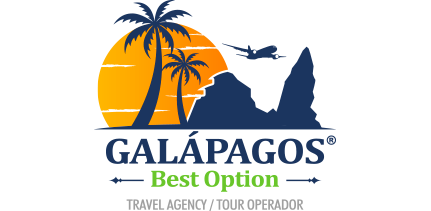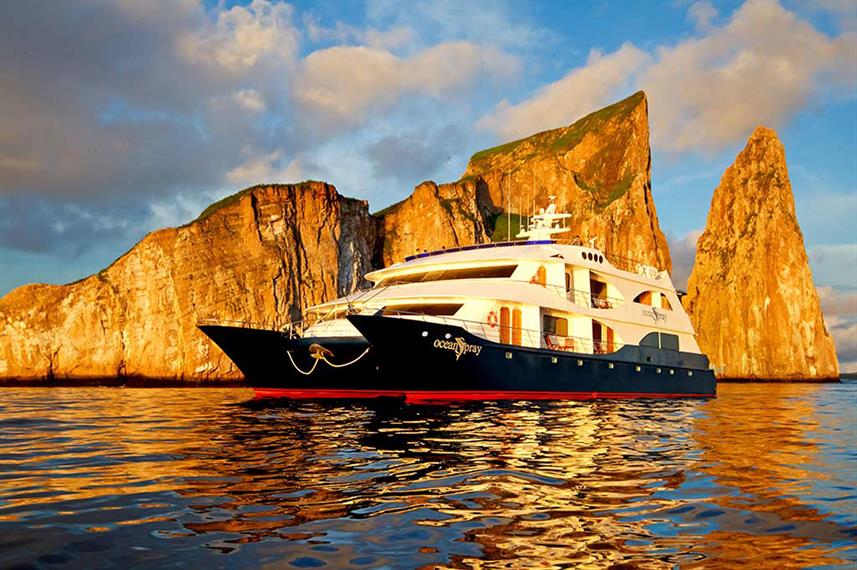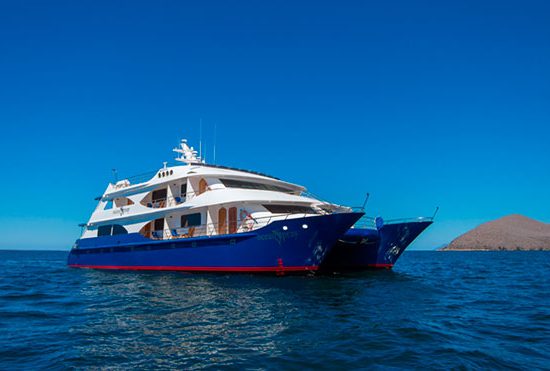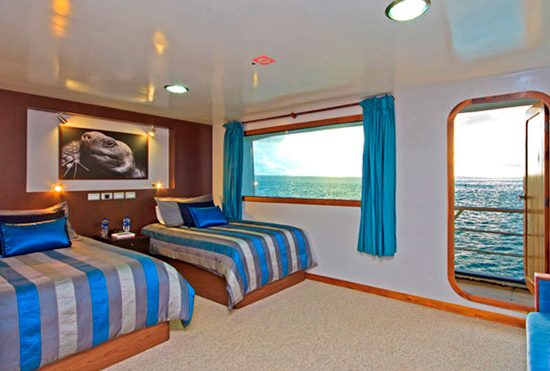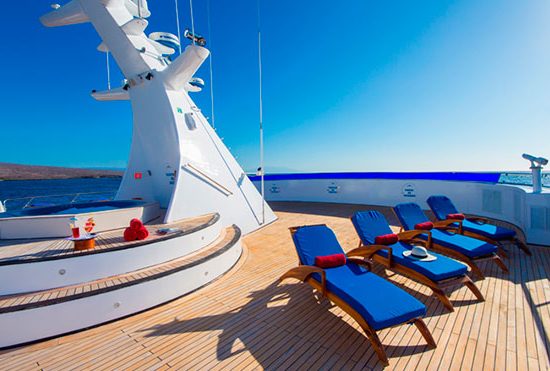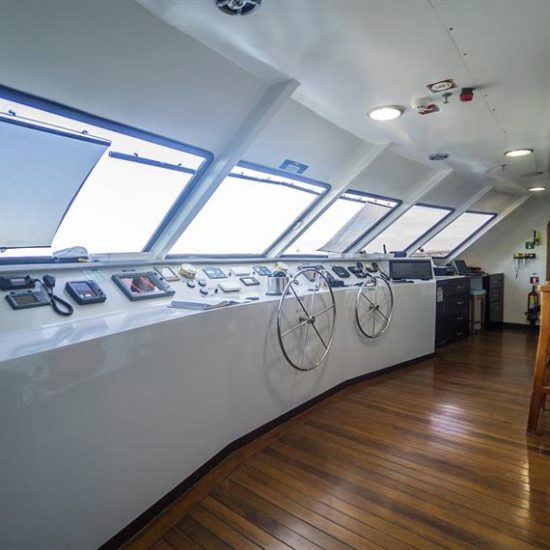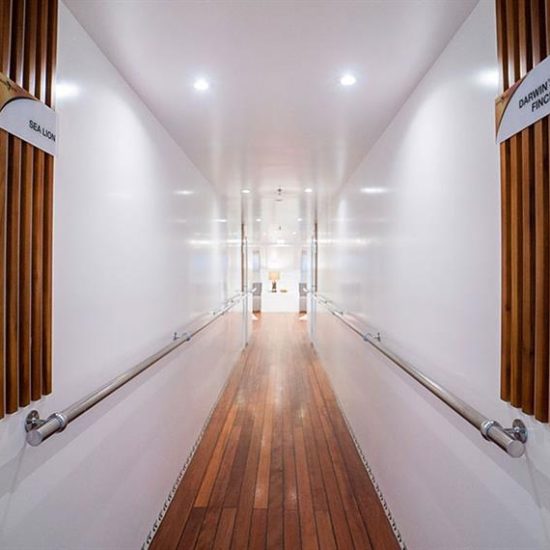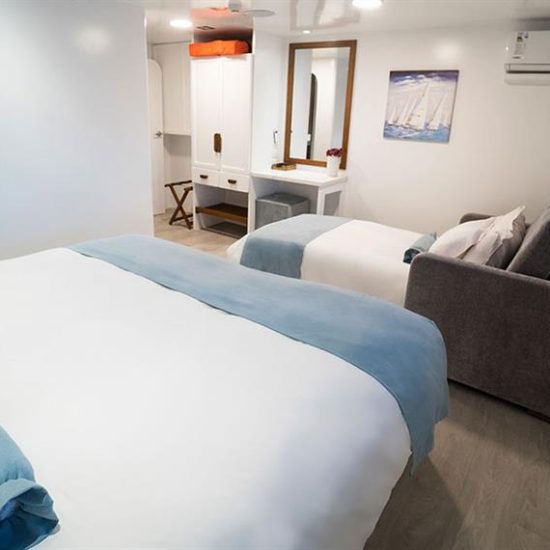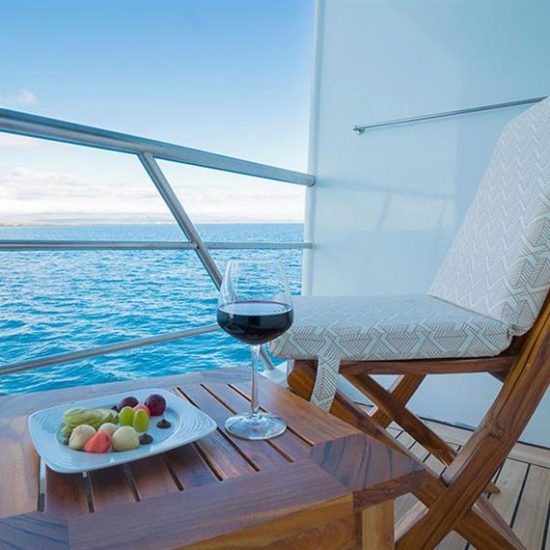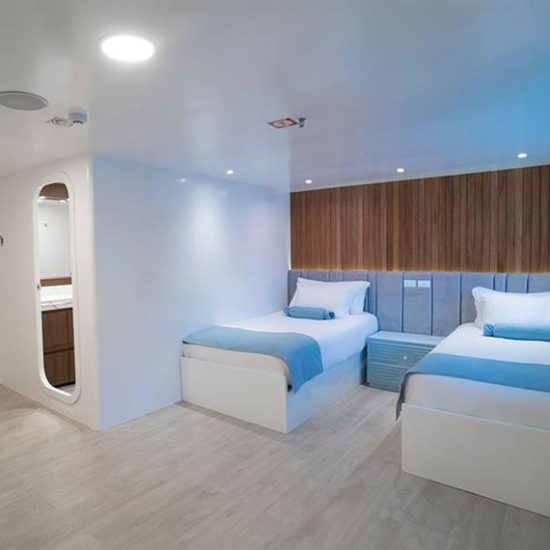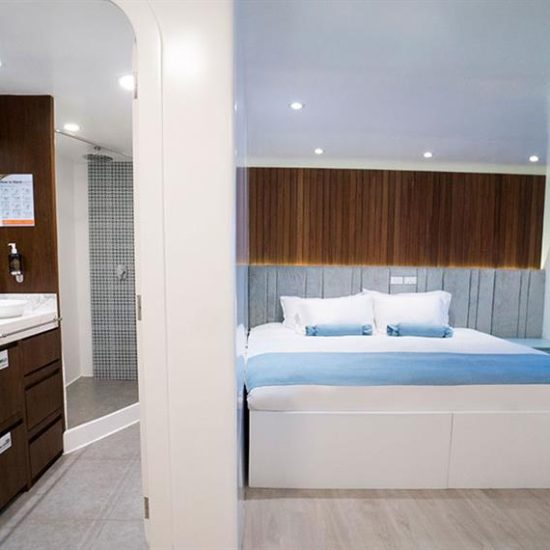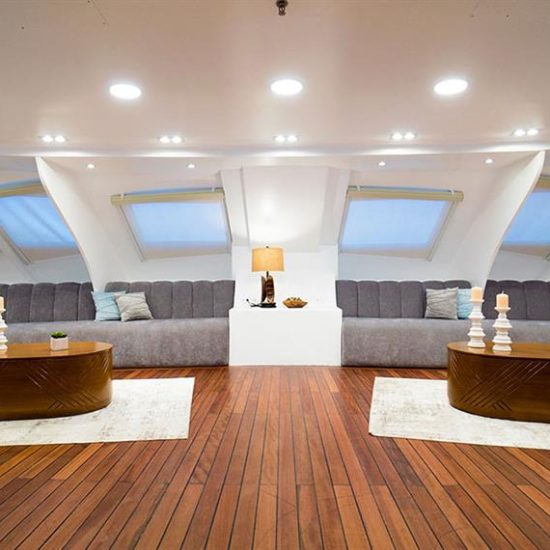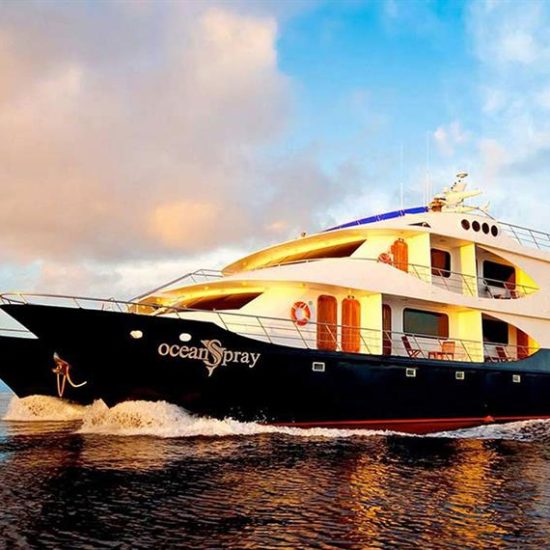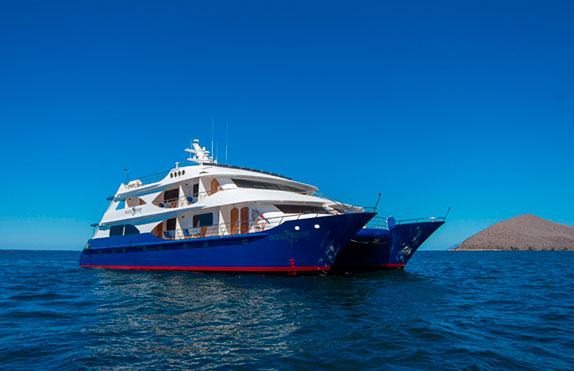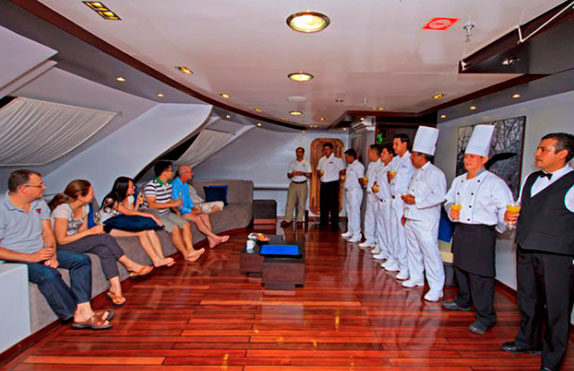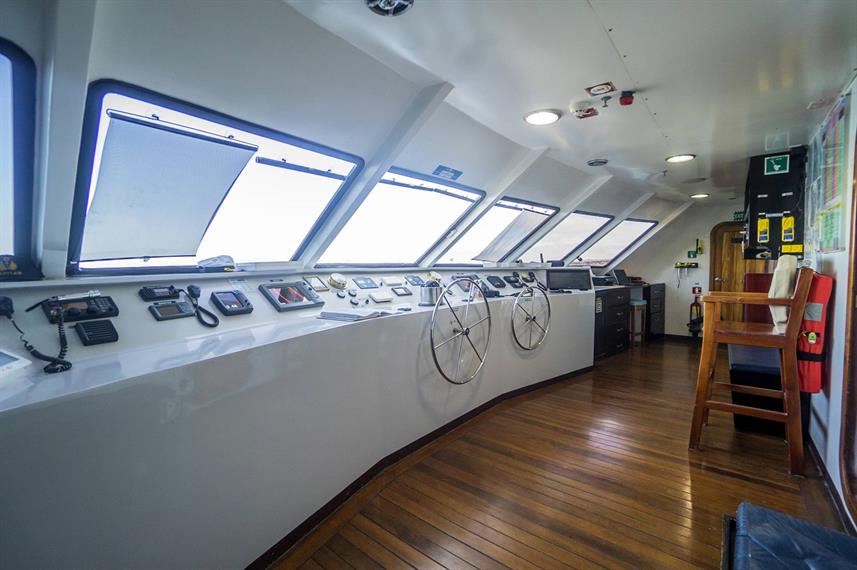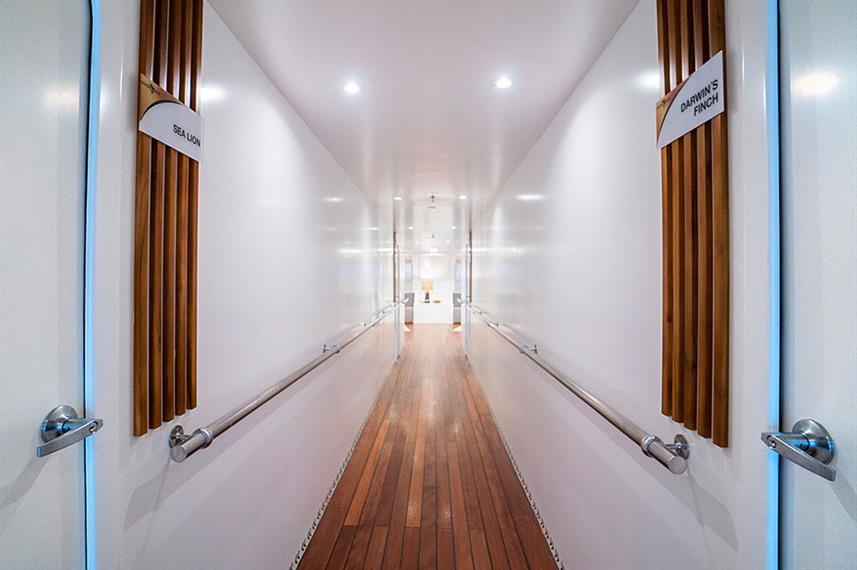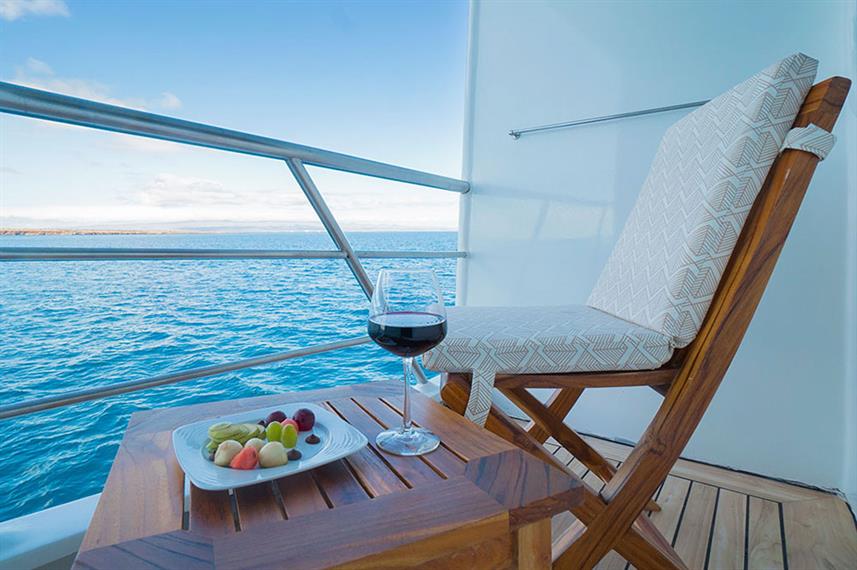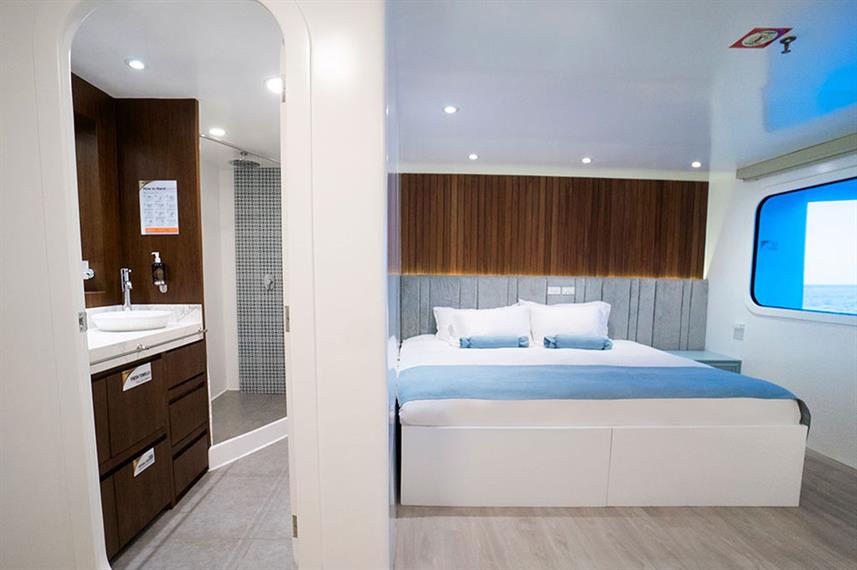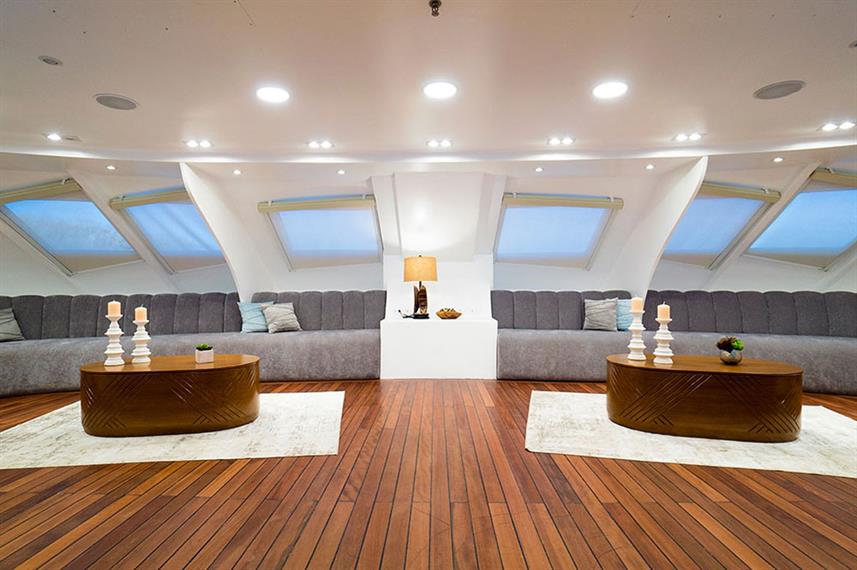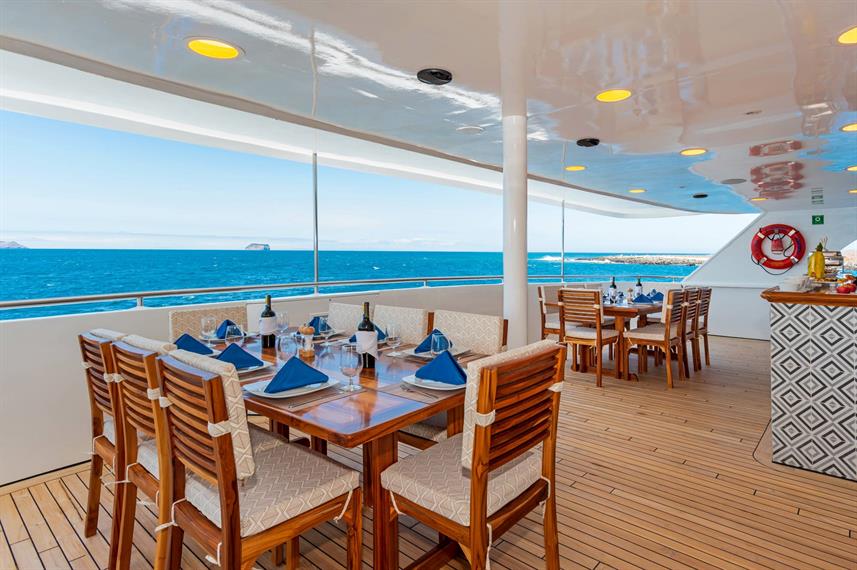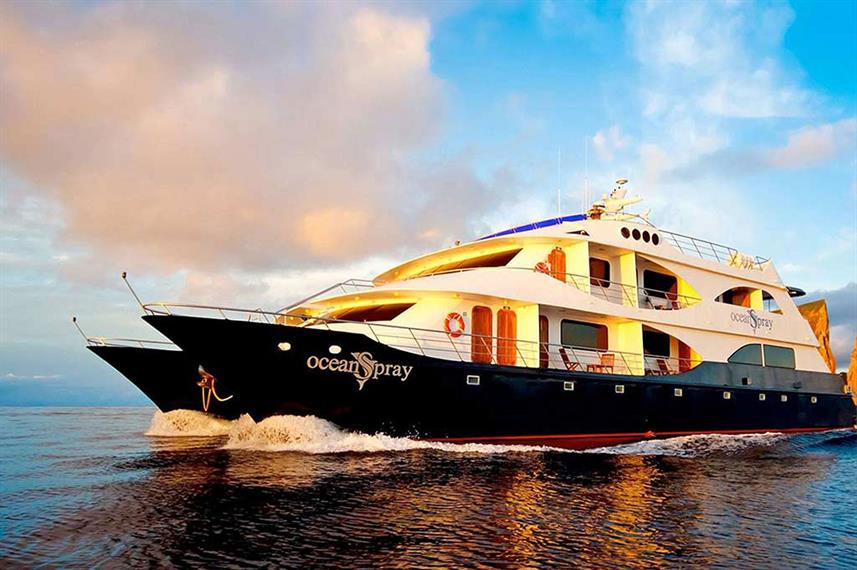Ocean Spray Catamaran
The Ocean Spray Mega-Catamaran offers year-round exciting cruises to the Galapagos Islands. Built for comfort and performance, the 34m/113ft catamaran caters to just 16 guests in 9 tasteful cabins. Each cabin has ample storage and living space, en-suite bathroom, AC, twin or double beds and private balcony to enjoy the stunning Galapagos views. Social areas include the indoor lounge and dining area, spacious sun deck with loungers and hot tub and al-fresco deck with bar and dining area. Guests will receive a champagne reception, and all meals, soft drinks and juices are included throughout the cruise.
RESERVE THIS CRUISE
Starting Price Per Person: $4.199,00 USD, all taxes are included.
Please confirm availability for your desired itinerary by contacting us at:
info@galapagosbestoption.com / sales@galapagosbestoption.com / Whatsapp +593 967742545
PAYMENT POLICY
To book and confirm any tour, we must receive 100% of the total amount prior to the tour as follows:
50% due at the time of booking
50% due two weeks before the date of your tour
CANCELLATIONS
Any last minute cancellations or changes by the customer may incur a fee to be imposed by Galapagos Best Option SA.
If for any reason a passenger is not present at the time of their flight they will be considered a no show and will not be subject to any refund by the agency.
Please read our full Cancellation and Refund Policy.
The Galapagos National Park has the right to make any changes to the itinerary due to natural disasters or scientific research projects.
ITINERARY A
8 DAYS
Day 1: Saturday
AM: Baltra Airport and Transfer to the M/C Ocean Spray.
Briefing of Activities
Navigation
PM: Chinese Hat
This site offers rare, up-close viewing of Galapagos wildlife and well-preserved remnants of fragile volcanic rock that can't be found in such a unique condition anywhere else. The island is named after the similarity of an Asian type of hat. Here, you can see American Oystercatchers and Galapagos Penguins swimming along the shores.
Day 2: Sunday
AM: Isabela - Vicente Roca Point
Vicente Roca Point has outstanding geological formations and is a great place to see various bird species. Because this visitor site is located on the western area of the island, the Cromwell Current provides cold water that carries many nutrients for both land and aquatic species, offering the chance to see amazing feeding frenzies.
PM: Fernandina - Espinosa Point
As one of the most pristine islands in the archipelago, Fernandina has never had a foreign species invade. It is also the most active island and farthest west. Espinosa's point is the only visitor site on the entire island. Here, you can see marine iguanas, Galapagos hawks, and enjoy a hike and/or snorkeling activity at one of the most natural, unspoiled sites in the entire world.
Day 3: Monday
AM: Isabela - Tagus Cove
If you like historic remnants, then you will enjoy finding what was left behind by pirates and sailors in the 1800s. This site was one of their preferred pit stops while traveling the seas. The hike here will provide incredible views of the cove and on the other side the mangrove forest where the last 35 pairs of Mangrove finches thrive.
PM: Isabela - Urbina Bay
Millions of years ago, Urbina Bay was once laying on the ocean floor. Volcanic uplifts caused it to rise and now it is occupied by sea lions, land iguanas, and flightless cormorants. It is a great place to enjoy some free time on the beach or the guide may suggest a hike.
Day 4: Tuesday
AM: Isabela - Elizabeth Bay
This visitor site is visited by panga only as the park authorities have no authorized landing in order to protect the island. While in the panga you can appreciate a large abundance of marine life that can be seen in the clear waters. It is great for snorkeling.
PM: Isabela - Moreno Point
The beautiful rocky shores of Moreno Point offer a plethora of birds to be seen. It is truly a birder's delight. The main attraction is the coast lagoons where white-tipped sharks can be seen and the panoramic views of Sierra Negra and Cerro Azul volcanoes cannot be missed.
Day 5: Wednesday
AM: Santa Cruz - Charles Darwin Research Station
The Charles Darwin Research Station is one of the Galapagos Island’s most important sites for visitors. It is a research facility that has an extensive collection of Galapagos plant life specimens carefully preserved and also acts as a biological research station and active breeding center operated by the Charles Darwin Foundation. Their biggest conservation efforts are to one day eliminate all invasive and non-native plants and animals destroying endemic species within the islands.
PM: Santa Cruz - Highlands
The highlands are located in the northern part of Santa Cruz and can reach elevations up to 1500 meters. This area is rich with hills, ferns, volcanoes, and wildlife. A great contrast to the molten lava hardened beaches and rocky areas of other islands already seen. It is home to giant tortoises, mockingbirds, finches, and many other species.
Day 6: ThursdayAM: South Plaza Island
South Plaza is one of the smallest islands with a visitor site but is home to an incredible amount of diverse flora and fauna. It has a large population of Sesuvium plants like the prickly pear cactus tree that is an important source of food for the land iguana. Just a few years ago mice were finally eradicated from the island, helping the population of land iguanas grow healthily once more. The amazing colors of the turquoise waters against the black lava create a setting for amazing photography opportunities.
PM: Santa Fe Island
Santa Fe is home to the endemic Santa Fe iguana. The island was created by a volcanic uplift that now hosts a forest of Opuntia and Palo Santo trees. It is a picturesque island with two different trails, one leading to a scenic viewpoint and the other leading to a small beach. Giant tortoises were once native here but went extinct after pirates and sailors took them aboard as a source of food.
Day 7: Friday
AM: Española-Suarez Point
This is a phenomenal site where you will get to see many of Española Island's endemic species. The trail will pass by the only Waved Albatross breeding site in all of the Galapagos. If you are lucky you might see a young albatross take off for its first flight for up to five years at sea. Older birds stay at sea for months at a time, only coming back to breed. They have the same mate for life and will meet each other each year, only here to reproduce. Other species that can be seen are marine iguanas that stay brightly colored year-round, Galapagos doves, Nazca boobies, blue-footed boobies, swallow-tailed gulls, red-billed tropicbirds, and Darwin finches.
PM: Española-Gardner Bay/Osborn Islet
This white sandy beach is home to a large colony of sea lions and incredibly blue and turquoise waters. Three different finches can be seen, as well as the Española mockingbird. Over time, the mockingbird must have been offered water or food from tourists and now they have no fear of walking on your things or landing very close to you. It is so important not to feed or touch the animals. It can disrupt their normal behaviors and threaten their future.
DAY 8 SATURDAY
AM: San Cristobal-Interpretation Center and Galapaguera
The Interpretation Center has been open to the public since 1998, offering extensive knowledge about the history of the Galapagos. San Cristobal is also the island where Charles Darwin first landed on. It is now home to the capital of Galapagos and houses many government offices, as well as part of the Ecuadorian Navy. Giant tortoises are bred at the Galapaguera and roam in a semi-natural habitat created by the center.
PRICE : 9499,00 USD P.P.
ITINERARY B
8 DAYS
Depart from San Cristobal airport.
After this last visit, transfer to San Cristobal airport for your return flight to mainland Ecuador. Assistance and farewell at the airport.
Itineraries are subject to change without prior notice due to weather conditions, National Park regulations, emergencies on board, or any unforeseen situation.
Arrival/Departure: When arriving at the Galapagos airport, you must first pass through the Galapagos National Park entrance and then onto baggage claim. Continuing through the airport with your baggage, you will scan your belongings once more and then finally pass through.
6 Day Cruise
Itinerary B
Day 1: Thursday
AM: Arrival to Baltra Airport with transfer to M/C Ocean Spray
Welcome to the Galapagos Islands aboard the M/C Ocean Spray. The guide and crew will greet you and show you to your accommodations upon your arrival. Afterward, the guide and cruise manager will hold a short briefing on all safety and emergency protocols, different areas of the vessel, and the normal routine of the itinerary.
PM: Santa Fe Island
Santa Fe is home to the endemic Santa Fe iguana. The island was created by a volcanic uplift that now hosts a forest of Opuntia and Palo Santo trees. It is a picturesque island with two different trails, one leading to a scenic viewpoint and the other leading to a small beach. Giant tortoises were once native here but went extinct after pirates and sailors took them aboard as a source of food.
Day 2: Friday
AM: Española - Suarez Point
This is a phenomenal site where you will get to see many of Española Island's endemic species. The trail will pass by the only Waved Albatross breeding site in all of Galapagos. If you are lucky you might see a young albatross take off for its first flight for up to five years at sea. Older birds stay at sea for months at a time, only coming back to breed. They have the same mate for life and will meet each other each year, only here to reproduce. Other species that can be seen are marine iguanas that stay brightly colored year-round, Galapagos doves, Nazca boobies, blue-footed boobies, swallow-tailed gulls, red-billed tropicbirds, and Darwin finches.
PM: Española - Gardner Bay/Osborn Islet
This white sandy beach is home to a large colony of sea lions and incredibly blue and turquoise waters. Three different finches can be seen, as well as the Española mockingbird. Over time, the mockingbird must have been offered water or food from tourists and now they have no fear of walking on your things or landing very close to you. It is so important not to feed or touch the animals. It can disrupt their normal behaviors and threaten their future.
Day 3: Saturday
AM: San Cristobal - Interpretation Center and Galapaguera
The Interpretation Center has been open to the public since 1998, offering extensive knowledge about the history of Galapagos. San Cristobal is also the island where Charles Darwin first landed on. It is now home to the capital of Galapagos and houses many government offices, as well as part of the Ecuadorian Navy. Giant tortoises are bred at the Galapaguera and roam in a semi-natural habitat created by the center.
PM: San Cristobal - Lobos Island/Kicker Rock
Lobos Island is aptly named after the many sea lions that reside here resting and playing along the rocky shores. It is also home to many different birds like pelicans, frigate birds and their nests, yellow warblers, and more. Within the small channel, the waters are very clear, making it easy to find sea turtles, sea lions, stingrays, and perhaps even white-tipped sharks. Kicker Rock is one of the most extraordinary sites in the Galapagos Islands, made of two eroded volcanic cones that tower over the sea at about 104 meters in the middle of the open water. It is one of the best sites in Galapagos to see incredible underwater life.
Day 4: Sunday
AM: San Cristobal - Pitt Point
When arriving at Pitt Point, it will feel as if you’ve landed on an extraterrestrial planet. You can see the many different developments over time of how volcanic activity formed this island. A hike up to the top beholds amazing views of the surrounding waters. Watch out for blue-footed booby nests on the ground and keep an eye out for the red-footed boobies nesting in the trees once you reach the top of the island.
PM: San Cristobal - Witch Hill
Witch hill has awesome crevices and eroding rocks along the shoreline where you will first pass in a panga. Afterward, be prepared to visit a powdery white sand beach with teal and turquoise waters.
Day 5: Monday
AM: Floreana - Post Office Bay
Ask the Cruise Manager for one of our complimentary postcards to write a message and address it home. Leave it in the barrel used before by pirates and sailors. While you are there, see if there are any other postcards you can take home with you to send for fellow travelers who have already left their messages!
PM: Floreana - Cormorant Point/Devil’s Crown
Cormorant is an interesting visitor site. Two beaches can be visited here, just beyond the first beach is a saltwater lagoon with flamingos. One of the beaches looks green because of the olivine crystals, and the other is appropriately called Flour Beach because of the powdery white sand, made from the fine, pulverized coral. Watch your feet if wading in the water, stingrays love to hang out here as well. Devil’s Crown boasts one of the finest snorkeling opportunities. Below the surface are amazing volcanic structures that have submerged over time. Hundreds of colorful fish species can be seen along the reef, along with sharks, rays, sea turtles, sea lions, and rays. It’s a beautiful underwater spectacle that cannot be missed.
Day 6: Tuesday
AM: Santa Cruz - Black Turtle Cove
Black Turtle Cove is located on the north side of Santa Cruz Island. This shallow inlet is surrounded by mangroves and provides natural protection for a variety of marine life, attracting the vulnerable juveniles of many species. Below the surface of the water, you can see both black-tip and white-tip reef sharks, sea turtles, golden cow-nose rays, and spotted eagle rays. Pelicans and blue-footed boobies hunt here, diving gracefully into the water.
PRICE : 7199,00 USD P.P.
Important Info: Itineraries are subject to change due to many different elements such as weather, park authorities and regulations, airline operations out of operator's control, guide experience, and safety concerns.
5 Day Cruise
Itinerary B
Day 1: Tuesday
AM: Upon arrival, reception, and assistance at the airport, transfer from Baltra Airport to the M/C Ocean Spray.
PM: Bartholomew-Pinnacle Rock
Pinnacle Rock is a volcanic cone formed by magma expelled by an underwater volcano. These cooled the hot lava and as it exploded from contact, the pieces formed together this huge rock of many, many layers of basalt. The huge rock also has a beach where a small population of green sea turtles will nest during the breeding season. Galapagos penguins gather here and swimming can offer beautiful sights of colorful schools of fish and curious sea lions.
Day 2: Wednesday
AM: Genovesa-Darwin Bay
Darwin Bay used to be a shield volcano, now you can see where one of the sides of its caldera collapsed after hundreds of years of erosion. It is known for the wide variety of birds that can be seen. Over 20,000 red-footed boobies are estimated to call this island home within the trees and bushes of Genovesa Island.
.PM: Genovesa-El Barranco
In English, this visitor site is also known as Prince Phillip’s Steps. It leads to a rocky path up a cliff that rewards guests with a remarkable view. It is also home to a Palo Santo forest that is home to the nesting red-footed boobies and other shorebirds.
Day 3: Thursday
AM: Santiago-Espumilla Beach/Buccaneer Cove
As the second Island Charles Darwin discovered, it was originally named after King James of England. Buccaneer Cove is an excellent opportunity for snorkeling and was once a refuge for passing sailors and pirates. The underwater formations provide an amazing home for the many different tropical species of fish that can be found here.
PM: Santiago-Egas Port
Egas Port is also known as James Bay, home to quick-footed Galapagos lava lizards. There are grottos and tide pools housing all kinds of different marine species. This is also one of the best snorkeling sites in the Galapagos.
Day 4: Friday
AM: North Seymour Island
The island was named after English nobleman Lord Hugh Seymour. Formed by uplifted submarine lava, the island is home to a huge colony of about 2,500 land iguanas and large populations of sea lions, blue-footed boobies, common noddies, and frigatebirds. Along the coast, it is possible to see land and marine iguanas and the biggest colony of Magnificent Frigatebirds.
PM: Santa Cruz-Highlands
The Highlands of Santa Cruz is a very interesting site due to the rich wildlife, hills, ferns, volcanoes, and lava tubes present. Exploring the lava tubes is a surreal and unique experience. Here, you can see all the different agricultural zones that are present in the Galapagos in one place. The variety of birds makes this a bird watcher's delight.
Day 5: Saturday
AM: Mosquera Islet
This visitor site is located between the islands of Baltra and North Seymour. It is a reef of rocks and coral (the result of an uprising) and a great white sand beach. Its narrowest width reaches about 160 meters and has an estimated length of 600 meters. In most of the perimeter, there is a abase of lava rocks, as evidence of the lava uprising, except in the southwest side where the landing occurs. This island has one of the largest populations of sea lions. You can also observe several species of shorebirds. There have been occasional reports at this site of Orcas(Orcinus orca) feeding on sea lions.
Depart from Baltra airport. After this last visit, transfer to Baltra airport for your return flight to mainland Ecuador. Assistance and farewell at the airport.
Itineraries are subject to change without prior notice due to weather conditions, National Park regulations, emergencies on board, or any unforeseen situation.
Arrival/Departure: When arriving at the Galapagos airport, you must first pass through the Galapagos National Park entrance and then onto baggage claim. Continuing through the airport with your baggage, you will scan your belongings once more and then finally pass through.
PRICE : 5899,00 USD P.P.
ITINERARY C
4 DAYS
Day 1: Saturday
AM: Upon arrival, reception and assistance at the airport, transfer from San Cristobal Airport to the M/C Ocean Spray.
PM: San Cristobal-Lobos Island/Kicker Rock
Lobos Island is aptly named after the many sea lions that reside here resting and playing along the rocky shores. It is also home to many different birds like pelicans, frigate birds and their nests, yellow warblers, and more. Within the small channel, the waters are very clear, making it easy to find sea turtles, sea lions, stingrays, and perhaps even white-tipped sharks.
- Activities: Short hiking, swimming, and snorkeling.
- Difficulty: Easy/ModerateLanding:Dry landing
- Possible Wildlife: Sea lions, various shorebirds, sally lightfoot crabs, frigate birds, Galapagos sharks, schools of tropical fish, stingrays. Kicker Rock is one of the most extraordinary sites in the Galapagos Islands, made of two eroded volcanic cones that tower over the sea at about 104 meters in the middle of the open water. It is a nesting place of sea birds and a nice spot to take pictures while the vessels circumnavigate around the rock.
Activities: Circumnavigation
Type of Landing: No landing
(-, L, D)
Day 2: Sunday
AM: San Cristobal-Pitt Point
When arriving at Pitt Point, it will feel as if you’ve landed on an extraterrestrial planet. You can see the many different developments over time of how volcanic activity formed this island. A hike up to the top beholds amazing views of the surrounding waters. Watch out for blue-footed boobie nests on the ground and keep an eye out for the red-footed boobies nesting in the trees once you reach the top of the island.
- Activities: Hiking and kayaking.
- Difficulty: Moderate to Difficult
- Landing: Wet landing
- Possible Wildlife: Sea lions, various shorebirds, sally lightfoot crabs, Nazca boobies,blue-footed boobies, red-footed boobies.
PM: San Cristobal-Witch Hill
Witch hill has awesome crevices and eroding rocks along the shoreline where you will first pass in the panga. Afterward, be prepared to visit a powdery white sand beach with teal and turquoise waters.
- Activities: Panga ride, swimming, snorkel
- Difficulty: EasyLanding: Wet landing
- Possible Wildlife: sea lions, various shorebirds, finches, mockingbirds, tropical fish, and different crabs from the Sally lightfoot.
(B, L, D)
Day 3: Monday
AM: Floreana-Post Office Bay
Ask the Cruise Manager for one of our complimentary postcards to write a message and address it home. Leave it in the barrel used before by pirates and sailors. While your there, see if there are any other postcards you can take home with you to send to fellow travelers who have already left their messages!
- Activities: Post office barrel, relaxing on the beach, swimming or snorkeling
- Difficulty: Easy
- Landing: Wet landing
- Possible Wildlife: frigatebirds, sea lions, sea turtles, various shorebirds and seabirds, marine life.
PM: Floreana-Cormorant Point/Devil’s Crown
Cormorant is an interesting visitor site. Two beaches can be visited here, just beyond the first beach is a saltwater lagoon with flamingos. One of the beaches look green because of the olivine crystals, and the other is appropriately called Flour Beach because of the powdery white sand, made from the fine, pulverized coral. Watch your feet if wading in the water, stingrays love to hang out here as well. Devil’s Crown boasts one of the finest snorkeling opportunities. Below the surface are amazing volcanic structures that have submerged over time. Hundreds of colorful fish species can be seen along the reef, along with sharks, rays, sea turtles, sea lions, and rays. It’s a beautiful underwater spectacle that cannot be missed.
- Activities: Snorkeling and hiking
- Difficulty: Snorkeling-Moderate to difficult / Hike-easy
- Landing: Wet landing
- Possible Wildlife: frigatebirds, sea lions, sea turtles, Galapagos sharks, white-tipped sharks, tropical fish, various shorebirds and seabirds, varied marine life.
(B, L, D)
Day 4: Tuesday
AM: Santa Cruz-Black Turtle Cove
Black Turtle Cove is located on the north side of Santa Cruz Island. This shallow inlet is surrounded by mangroves and provides natural protection for a variety of marine life, attracting the vulnerable juveniles of many species. Below the surface of the water, you can see both black-tip and white-tip reef sharks, sea turtles, golden cow-nose rays, and spotted eagle rays. Pelicans and blue-footed boobies hunt here, diving gracefully into the water.
- Activities: Panga ride
- Difficulty: Easy
- Landing: No Landing
- Possible Wildlife: White-tipped sharks, rays, sea turtles, sea lions, and various shorebirds.
Depart from Baltra airport.
After this last visit, transfer to Baltra airport for your return flight to mainland Ecuador. Assistance and farewell at the airport.
PRICE : 4.199,00 P.P.
- Airport Transfers
- Naturalist Guide Certified by the Galapagos National Park
- Full Meals
- Coffee, Tea and Snacks
- Snorkel Gear (Mask, Fins and Snorkel)
- Wetsuit
- Private Bathroom With Hot Water
- Air Conditioning
- Entrance Fee to Galapagos National Park $100 USD
- Immigration Control Card $20 USD
- Personal Expenses
- Tips for the Crew and Guide
- Galapagos Flights ($450 to $550 USD – ask us for a quote!)
- Alcoholic Beverages and Soft Drinks

